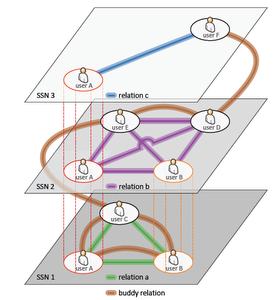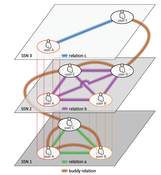Information
- Publication Type: Master Thesis
- Workgroup(s)/Project(s):
- Date: 2011
- First Supervisor:
Abstract
Social networks are a well researched field. There is extensive literature covering this topic. They are nowadays used for a wide variety of applications such as business, education, medicine and dating. These applications contribute to the high popularity of social networks. The underlying concept of all social networking applications is a graph, that consists of nodes representing people and edges representing social relations. This social graph is commonly very rigid in semantics and tedious to manipulate. Two users can add an edge only by mutually accepting the relation. Typically this graph manipulation needs manual intervention. In contrast, Spontaneous Social Networks (SSNs) rely on much more flexible graphs that are manipulated with minimal manual intervention. Edges are automatically generated and deleted in real time by hardware devices such as smartphones and desktop PCs. Applications operate on top of SSNs. The application defines the purpose and properties of the SSN and provides the users an interface to a SSN. The goal of this diploma thesis is the design of a standard and an implementation of a Spontaneous Social Networking (SSN) framework. The capabilities of the framework are demonstrated by a number of example applications. The Extensible Messaging and Presence Protocol (XMPP) and the Publish-Subscribe (PubSub) paradigm are used for communication in SSNs. The properties and discovery approaches of SSNs are defined. The implementation is evaluated in terms of usability with the help of the System Usability Scale (SUS). Furthermore, the suitability of XMPP and the scalability and privacy of SSNs and the reference implementation are discussed.Additional Files and Images
Weblinks
No further information available.BibTeX
@mastersthesis{hanzl-2011,
title = "Spontaneous Social Networks",
author = "Michael Hanzl",
year = "2011",
abstract = "Social networks are a well researched field. There is
extensive literature covering this topic. They are nowadays
used for a wide variety of applications such as business,
education, medicine and dating. These applications
contribute to the high popularity of social networks. The
underlying concept of all social networking applications is
a graph, that consists of nodes representing people and
edges representing social relations. This social graph is
commonly very rigid in semantics and tedious to manipulate.
Two users can add an edge only by mutually accepting the
relation. Typically this graph manipulation needs manual
intervention. In contrast, Spontaneous Social Networks
(SSNs) rely on much more flexible graphs that are
manipulated with minimal manual intervention. Edges are
automatically generated and deleted in real time by hardware
devices such as smartphones and desktop PCs. Applications
operate on top of SSNs. The application defines the purpose
and properties of the SSN and provides the users an
interface to a SSN. The goal of this diploma thesis is the
design of a standard and an implementation of a Spontaneous
Social Networking (SSN) framework. The capabilities of the
framework are demonstrated by a number of example
applications. The Extensible Messaging and Presence Protocol
(XMPP) and the Publish-Subscribe (PubSub) paradigm are used
for communication in SSNs. The properties and discovery
approaches of SSNs are defined. The implementation is
evaluated in terms of usability with the help of the System
Usability Scale (SUS). Furthermore, the suitability of XMPP
and the scalability and privacy of SSNs and the reference
implementation are discussed.",
address = "Favoritenstrasse 9-11/E193-02, A-1040 Vienna, Austria",
school = "Institute of Computer Graphics and Algorithms, Vienna
University of Technology ",
URL = "https://www.cg.tuwien.ac.at/research/publications/2011/hanzl-2011/",
}

 Thesis
Thesis

